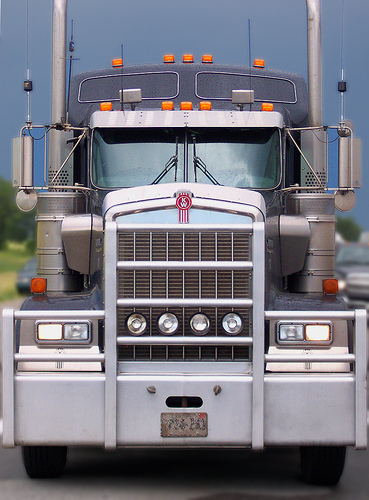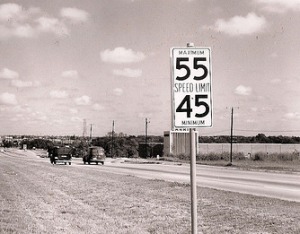The truck ahead of me was driving in the fast lane, and had been for 7 miles...
[caption id="attachment_475" align="aligncenter" width="369" caption="(flickr credit: C.P.Storm)"]
 [/caption]
[/caption]The good and bad of Professional truck drivers
I have a love-hate relationship with the commercial truck drivers on the road while I commute.
For the good, they are generally better drivers than the people in the cars. Professional drivers often don't get the consideration they deserve (which would make their jobs easier and less stressful). Because of their experience, training and the weight of their trucks, they tend to be patient and less impulsive. They perform very well in traffic and goodness knows many of these drivers are being watched with the "1-800 watch my driving" stickers and GPS logging. Sitting higher in traffic they often have better perspective than other drivers. Truck drivers are often proactive in traffic, using their rigs to smooth out traffic, turning potentially dangerous stop and go traffic into steady traffic (which queueing theory leads us to understand should improve the overall throughput of the highway). Often they can administer a unique kind of justice with the massive size of their trucks, returning the shoulders to their intended purpose from the "impromptu kamakaze right hand passing lanes". The professionalism is necessary because of the greater responsibility truck drivers have to keep their heavy vehicles and heavier loads from squishing families in mini-vans.
Normally "truckers" are great, but there are certainly a percentage of truckers whose impatience, indifference to human life, or incompetence regularly puts the lives of other drivers at risk. One day a truck travelled all the way from 176st in Surrey to Mt lehman in Abbotsford in the fast lane, which is a distance of 35 Km, then got out of the fast lane to exit the freeway. I've seen poorly adjusted brakes for empty or full trailers result in an impaired ability to stop in time. I've seen trucks blowing tires and not even noticing (or deciding that stopping isn't their best option) despite the obvious risk of flying steel belt radials on the freeway.
I'm interested in what strategies could be employed to make our roads safer within the bounds of our current transportation infrastructure.
Recording devices to help drivers obey traffic laws
I recall seeing on a trip to Europe that commercial buses and trucks at that time had a recording device (some use paper disks) which tracks the driver's speed, stops, breaks, sleep and other items relevant to safe vehicle operation. In any participating country, police can ask to see the record (paper disk), and can fine the driver for any infraction in the last 3 days, regardless of which country the driver was in when they committed the offence. It is remarkable to observer how obediently the trucks and buses follow the posted speed limit and other regulations. An environment is created where the rules apply whether there is a police officer in attendance or not, and as the driver of our tour bus explained, the fines imposed by automated systems like red light cameras, follow the license plate and then the driver themselves.
Most trucks I see on the freeway are driving close to the posted speed limits, others (like the dump truck with trailer that passed us doing about 140KM/H) need to be fined out of business and off the road for the safety and reputation of the other "good" drivers. No I didn't get the license because it was covered in mud.
Treating Trucks Differently
First of all; Trucks ARE different. Trucks are;
- slower to accelerate or climb a hill. In rush hour traffic, trucks appear to be the rocks in the stream with the cars being the water flowing around them.
- more intimidating if they choose to use their size and weight to "force" a lane change where it really shouldn't take place.
- generally travelling farther than other traffic
- more likely to throw rocks up at car windshields than other vehicles. (I suspect tire tread and weight is a factor)
- prone to kick up far more spray (reducing visibility) on wet roads, in rain storms and in loose dry snow
- big and reduce visibility by blocking the view of vehicles travelling behind them.
- heavier, harder to stop and much more deadly if they
- driven by drivers who typicaly have more training and experience than the rest of us.
I've observed three really useful strategies for "treating trucks differently";
- The first strategy I've see involves encouraging trucks to use some roads and cars to use others. Many cities have signs indicating "truck routes" and other signs indicating that only trucks making local deliveries are allowed on certain streets. In industrial areas, where corners are wider to allow for the special turning needs of the trucks, cars are the minority. Because cars and trucks typically don't mix, many of the issues that emerge when they mix are avoided.
- The second strategy I observed in Washington, Oregon & California, where they have a lower speed limit for trucks. The trucks are in the right hand lane (except to pass) abiding by a speed limit which is adequate, but 5-10 miles/hour slower than the cars. There is something predictable about trucks being on the right while other traffic flows past on the left. This ensures excellent visibility for the cars because the trucks are not impeding their vision.
- The third strategy I observed was in Germany on statutory holidays like "Fathers Day" when law requires that all transport trucks be off of the roads. "It is because so many more people are travelling for the holidays was the explanation offered by our bus driver". Every road side pullout or rest-stop was full of trucks, pennants draped across the front windows, drivers discussing European Football and catching up on sleep.
[caption id="attachment_476" align="aligncenter" width="300" caption="(flickr credit: austrini)"]
 [/caption]
[/caption]Perhaps those strategies have their place in British Columbia in the Lower Mainland. I think that our current highways require trucks and cars to use the same roads to go to the same places, so separate routes may not currently be feasible. While a lower speed limit for trucks might help trucks behave more predictably, I know all too well what happens when one driver gets stuck climbing a hill... everyone tries to pass, and here there are only two lanes so the problem snowballs and both lanes slow right down. It won't be a complete solution to our problem. I think however that the third solution might have merit if it were applied to rush-hour.
A suggested solution for improving rush hour traffic on the #1 highway in the lower-mainland is to create a time when cars can move without having trucks on the road.
In the past 40 years zero lanes have been added to widen the freeway. Our capacity to move traffic has not grown with the population and the traffic. Peak load on the freeway (6-8AM and 3-5PM) occurs because people must arrive at work within a limited time-frame. The absense of truly viable transit or any form of commuter rail in the South Fraser corridor means commuters are in cars. We must reduce the number of vehicles travelling on the freeway during rush "hour". The transport of many non-perishable goods in many cases is date sensitive and not time sensitive. Did the lumber arrive at 7PM or 3PM? It is still usable lumber. So truck traffic in many cases could be loading and unloading "at the dock" during rush hour, and then hitting the road as the commuters come off of those roads. If we were to regulate that commercial trucks could not be on the road during those hours, suddenly the "truck/car" dynamics would be gone and the roads would be largely homogenous and less full. Clearly there is more definition work to be identified. Where do the in-coming trucks "wait" if they arrive from outside the lower mainland? Chilliwack from the East or South Surrey from the USA? What trucks if any are exempt. are the 3ton cube trucks fine, but 18wheelers are out?
This may not be the idea that solves the interaction of commuters and heavy trucks during rush hour in the lower mainland of BC, but we need to do something... maybe several things to make life more reasonable for car and truck alike, in the interests of safety and efficiency.
Thanks for listening. I'm interested to hear your ideas.
Greg.
No comments:
Post a Comment